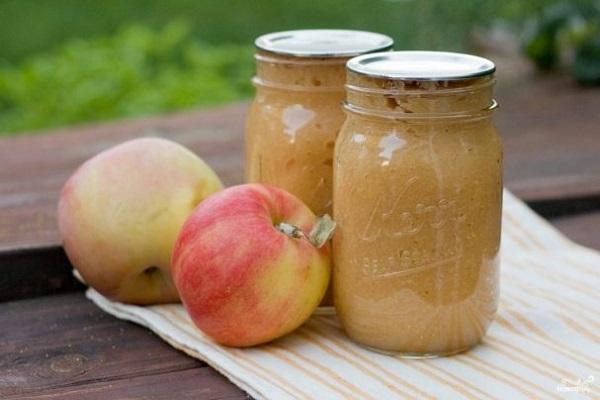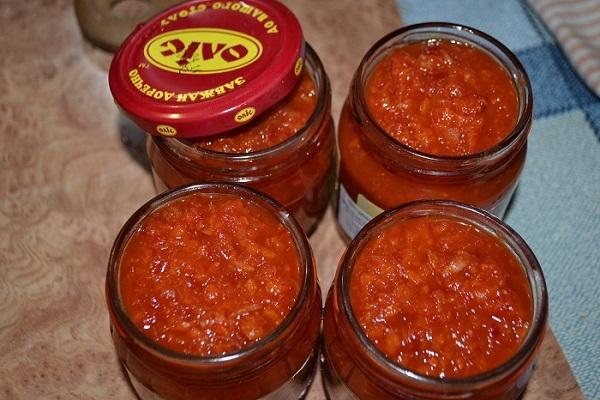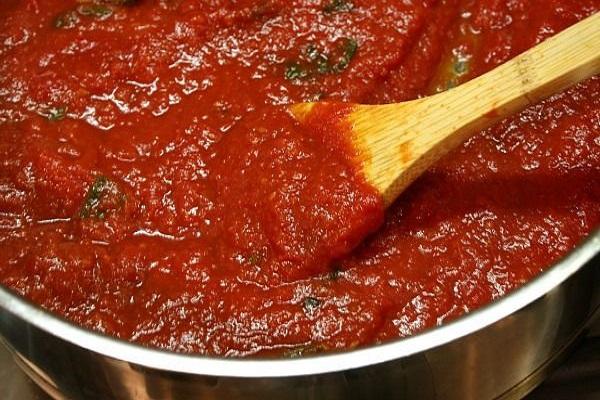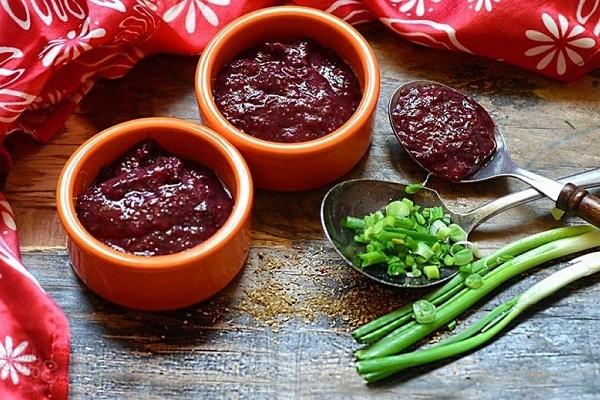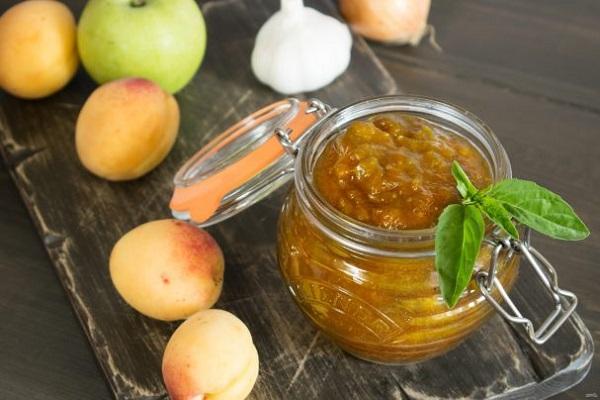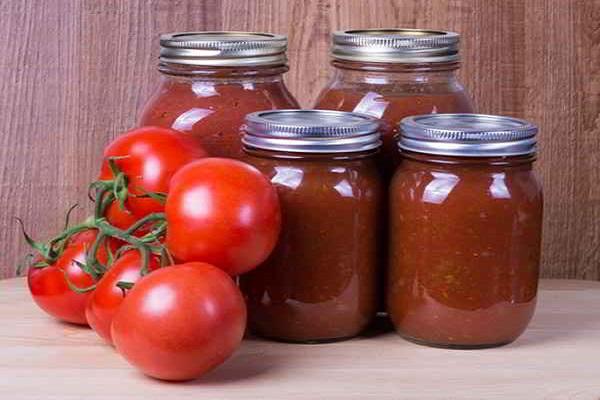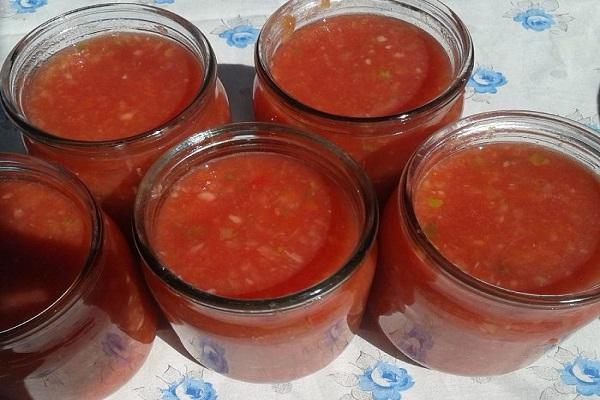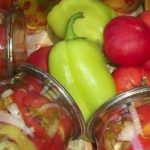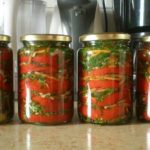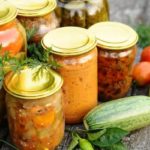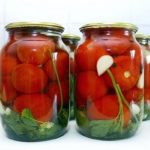Natural tasty preparations for the winter are the dream of any housewife. During the cold season, people especially need vitamins. If the recipe and correct preservation technology are followed, the finished vegetable dish or snack retains a full range of vitamins and minerals. How to prepare vegetable aromatic sauces and snacks for the winter, what original recipes to use.
- Features of preparing sauces for the winter
- Required containers
- Recipes for winter sauces at home
- Apple sauce
- Adjika with horseradish
- Adjika Korean
- Homemade tomato sauce
- Ketchup with onions
- Tomato sauce
- Tkemali sauce
- Eggplant in tomato-garlic sauce
- Apricot and apple sauce
- Sauce "Krasnodar"
- Dolmio sauce
- Thick tomato adjika with pears and basil for the winter
- Raw adjika from tomato, pepper and garlic with aspirin
- Vegetable sauce
- Further storage of preservation
Features of preparing sauces for the winter
In order for winter preparations to turn out tasty and become a source of pride and an excellent addition to delicious main courses, a number of requirements must be met:
- for cooking, use only fresh vegetables, preferably grown in your own garden;
- use sterilized containers;
- follow the recipe;
- To increase shelf life, use preservatives: vinegar or citric acid.
Note: the less vegetables are subjected to heat treatment, the more beneficial properties they will retain.
Required containers
Glass jars are the best container for storing food for the winter. Glass does not emit harmful substances at any temperature, products retain their true taste and aroma, and no foreign odors or tastes appear.
Glass jars are easy to sterilize, and aromatic snacks can be sealed with lids.
Recipes for winter sauces at home
Preparing winter snacks is a creative process. Each housewife creates her own unique recipes over time. Fresh tomatoes are an irreplaceable and main ingredient in delicious winter dishes.
Apple sauce
A fragrant, delicious tomato sauce with apple sourness for meat will decorate the table and will pleasantly surprise guests.
Peeled and cored apples are cut into cubes along with white onions and tomatoes. The resulting mass is poured into a non-stick pan and fried in a frying pan over low heat in its own juice for 20 minutes. Garlic is crushed with a garlic press and added when stewing vegetables along with pepper, salt and sugar.
Beat the contents of the pan with a blender and simmer for another 30 minutes.During this time, jars and lids are sterilized. 15 minutes before cooking, add vinegar. The rolled up cans are insulated with a blanket and placed next to the radiator.
Adjika with horseradish
A popular dish at Russian feasts is adjika with horseradish - a spicy appetizer for meat dishes and shish kebab. A proven, finger-licking remedy for colds and flu.
To create a culinary masterpiece you will need the following ingredients:
- tomatoes – 3 kilograms;
- sweet bell pepper – 1 kilogram;
- grated horseradish – 400 grams;
- garlic – 7-9 heads;
- peppercorns – 300 grams;
- a mixture of aromatic ground peppers - to taste;
- fresh chili pepper - to taste;
- vinegar 9% - 10 tablespoons;
- refined sunflower oil – 1 cup;
- salt, sugar - to taste.
Fresh red tomatoes and sweet red bell peppers are passed through a food processor or meat grinder. Add grated horseradish and fresh garlic to the resulting mixture. The aromatic gruel is mixed, put on fire and cooked for about an hour. 20 minutes before readiness add salt, sugar, all types of peppers, vinegar and grated chili.
Hot adjika is placed in sterilized jars.
Adjika Korean
Everything is the same as in the recipe for classic adjika with horseradish, only the list of vegetables is replenished with carrots. For 1 kilogram of tomatoes you need to use 500 grams of carrots. Korean adjika is an awesome sauce for meat dishes.
Homemade tomato sauce
A classic sauce that can be used to season soup and use instead of store-bought ketchup. Tasty, healthy and very simple.
Tomatoes and onions are passed through a food processor or meat grinder. The resulting mass is poured into a saucepan and put on fire; the pulp should be cooked for about an hour.Seasonings, salt and sugar are added in 20 minutes. After cooking is completed, the resulting pulp is rubbed through a sieve; the cake is no longer needed.
Next, the sauce must reach the required consistency; it must be evaporated. Cook for about an hour, add vinegar 10 minutes before cooking. The snack is ready, all that remains is to roll it into sterile jars.
Ketchup with onions
This ketchup does not have to be rolled into jars. Ketchup is immediately ready for use; you can use regular screw caps.
Grind all the ingredients through a food processor or meat grinder and simmer over low heat in a non-stick pan for 40 minutes. 10 minutes before readiness, add salt, sugar, vinegar. When hot, place into prepared containers. The canned sauce is ready.
Tomato sauce
As a basis, you need to take the recipe for making homemade tomato sauce given above. To give the dish an original taste, it is recommended to add the following components to the sauce after evaporation:
- grated basil;
- finely chopped fresh garlic;
- nutmeg;
- rosemary.
Cook the mixture with these additives for 5-10 minutes and roll into jars.
Tkemali sauce
Caucasian seasoning, indispensable for garnishing meat dishes cooked over charcoal. To prepare tkemali you will need:
- pitted plums – 1.5 kilograms;
- fresh garlic - 8 cloves;
- salt, sugar - to taste;
- seasonings - fresh cilantro, basil, chili pepper, mint, suneli hops.
Peeled plums are covered with sugar (three heaped tablespoons are enough) and left for a day to release the juice. Then the plums are transferred to a saucepan and placed on low heat, adding water, boil for 5 minutes.Then the mass is rubbed through a sieve and boiled again, the consistency should be quite thick.
Next add salt, sugar, all seasonings, cook for another 10 minutes. The sauce is ready, you can put it in jars for the winter or put it in the refrigerator.
Eggplant in tomato-garlic sauce
It is used as a juicy, aromatic addition to meat dishes, and also as a self-sufficient side dish.
All fresh vegetables are ground in a meat grinder, except eggplants. They need to be cut into cubes and added to the resulting mass. Place on low heat and cook for about 35-40 minutes. As soon as the mixture boils, add salt, spices, and 10 minutes before the mixture is ready, add vinegar. The sauce is ready to be put into jars.
Apricot and apple sauce
Exquisite sauce for fish dishes. Ingredients:
- apples – 500 grams;
- apricots – 500 grams;
- onions – 2 heads;
- garlic – 3 cloves;
- wine vinegar - 150 milliliters;
- ginger – 2 teaspoons;
- salt, sugar - to taste.
Cut all ingredients into cubes and simmer in a frying pan for 15 minutes, then grind with a blender. Cook the resulting pulp over low heat for another 20 minutes, adding salt, sugar, ginger and vinegar. Store the finished sauce in the refrigerator in jars under screw caps.
Sauce "Krasnodar"
The recipe for apple sauce given above can be used as a basis for preparing the traditional Krasnodar sauce. It is enough to increase the amount of tomatoes and add ground cinnamon and nutmeg as seasonings.
The sauce is rolled up under tin lids for the winter. You can store it in a cool, dark place.
Dolmio sauce
Italian sauce for pasta. Ingredients:
- tomatoes – 1 kilogram;
- sweet red bell pepper – 500 grams;
- dried basil, oregano, ground red pepper - to taste;
- salt, sugar.
Finely chopped ingredients are simmered over low heat for about an hour. To seal the jars, add citric acid or vinegar.
Thick tomato adjika with pears and basil for the winter
To the classic adjika recipe add finely chopped fresh basil and pears to taste. To add piquancy, the sauce can be seasoned with apple cider vinegar. The basic rule is to cook the mass until a thick consistency is formed, drain off the excess juice.
Raw adjika from tomato, pepper and garlic with aspirin
Prepare tomato sauce without sterilization. Aspirin plays the role of vinegar. Ingredients:
- tomatoes – 2 kilograms;
- red bell pepper – 500 grams;
- chili pepper – 3 pieces;
- garlic – 10 cloves;
- salt, sugar, seasonings - to taste;
- Aspirin – 7 tablets.
Grind all the vegetables in a food processor (with the attachment you like) or a meat grinder; grind the garlic in a garlic press. Add sugar, salt and spices to taste to the resulting aromatic mass. Grind the aspirin into powder and add to the rolled mixture.
Mix thoroughly, cover and leave in the refrigerator overnight. In the morning, place adjika into jars under plastic lids and store.
Vegetable sauce
A cook's dream and fantasy. The sauce is prepared from available vegetables using classical technology. You can add zucchini, carrots, pumpkin, and so on to homemade tomato sauce. The recipe depends on the desires and capabilities of the cook.
Further storage of preservation
Snacks rolled up in sterilized jars can be stored in the basement or other dark, cool place. Products with low or no preservative content are placed in the refrigerator.
The shelf life will vary: the more vinegar you add, the longer the jars will last. If the sterilization process is violated, pathogenic bacteria may enter the sauce and the product will be damaged.
The preservation process is labor-intensive; if you are not confident in your abilities, choose a recipe with the ability to consume the snack in a few days.
With strict adherence to the recipe and preservation process, the preparations will turn out tasty and healthy. Bon appetit!


